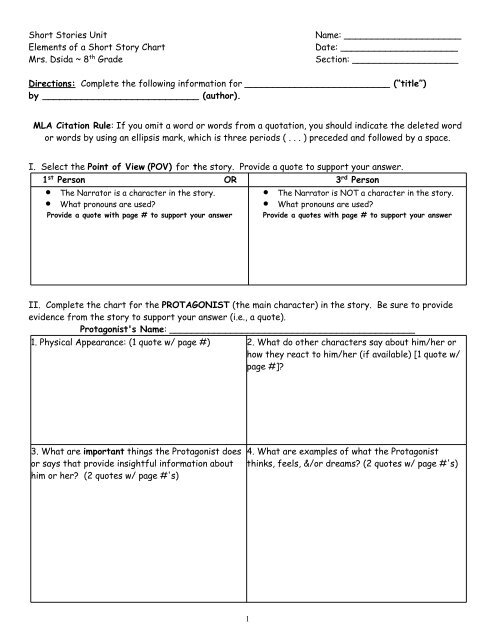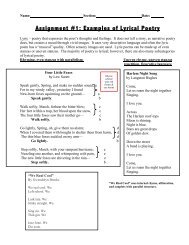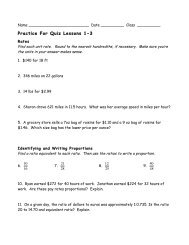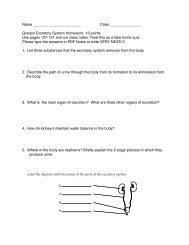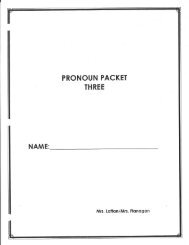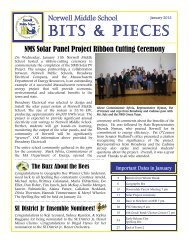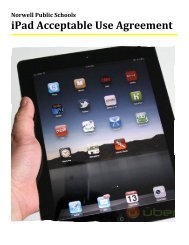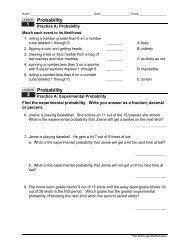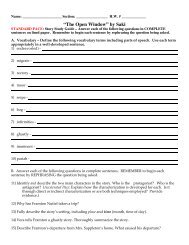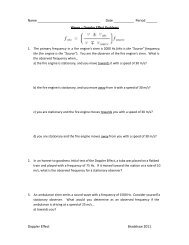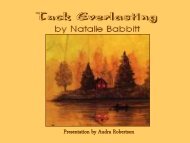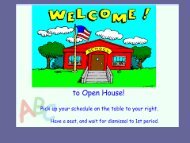Blank Short Story Elements Chart2012 - Norwell Public Schools
Blank Short Story Elements Chart2012 - Norwell Public Schools
Blank Short Story Elements Chart2012 - Norwell Public Schools
You also want an ePaper? Increase the reach of your titles
YUMPU automatically turns print PDFs into web optimized ePapers that Google loves.
<strong>Short</strong> Stories Unit<br />
<strong>Elements</strong> of a <strong>Short</strong> <strong>Story</strong> Chart<br />
Mrs. Dsida ~ 8 th Grade<br />
Name: _____________________<br />
Date: _____________________<br />
Section: ___________________<br />
Directions: Complete the following information for __________________________ (“title”)<br />
by ____________________________ (author).<br />
MLA Citation Rule: If you omit a word or words from a quotation, you should indicate the deleted word<br />
or words by using an ellipsis mark, which is three periods ( . . . ) preceded and followed by a space.<br />
I. Select the Point of View (POV) for the story. Provide a quote to support your answer.<br />
1 st Person OR 3 rd Person<br />
The Narrator is a character in the story.<br />
The Narrator is NOT a character in the story.<br />
What pronouns are used<br />
What pronouns are used<br />
Provide a quote with page # to support your answer Provide a quotes with page # to support your answer<br />
II. Complete the chart for the PROTAGONIST (the main character) in the story. Be sure to provide<br />
evidence from the story to support your answer (i.e., a quote).<br />
Protagonist's Name: ____________________________________________<br />
1. Physical Appearance: (1 quote w/ page #) 2. What do other characters say about him/her or<br />
how they react to him/her (if available) [1 quote w/<br />
page #]<br />
3. What are important things the Protagonist does<br />
or says that provide insightful information about<br />
him or her (2 quotes w/ page #'s)<br />
4. What are examples of what the Protagonist<br />
thinks, feels, &/or dreams (2 quotes w/ page #'s)<br />
1
III. Identify the Antagonist (or Antagonistic Force) in the short story. The Antagonist is the character<br />
or force that is in conflict with the protagonist and keeps the protagonist from getting what he or she<br />
wants. (FYI: The struggle between the two becomes the central conflict.)<br />
____________________________________________________________________________<br />
____________________________________________________________________________<br />
IV. Identify the Conflict in the short story.<br />
A. Formula to identify Conflict:<br />
What the Protagonist wants<br />
+ The Antagonist (the force that keeps Protagonist from getting what S/He wants<br />
= Conflict<br />
____________________________________________________________________________<br />
____________________________________________________________________________<br />
B. What kind of Conflict is it The types of conflict include: external: person vs. person, person vs.<br />
nature, person vs. society, and person vs. supernatural force or internal: person vs. self.<br />
____________________________________________________________________________<br />
____________________________________________________________________________<br />
V. Complete the following chart based on the SETTING of the short story. Not all aspects of the setting<br />
are applicable.<br />
Time:<br />
Place:<br />
Weather:<br />
Mood*:<br />
Social Conditions**:<br />
Is the setting critical to the short story Why or<br />
Why not<br />
*Determine how the author’s word choice appeals to the reader's senses and feelings.<br />
**Daily life of the characters; writing that focuses on the speech, dress, mannerisms, customs, etc. of a<br />
particular place and time, historical context<br />
2
VI. Identify each element of the PLOT of the short story.<br />
1. Introduction (Exposition) [introduces the<br />
setting, character, & main conflict]<br />
2. Rising Action (2 event minimum)<br />
3. Climax/Turning Point 4. Falling Action (2 event minimum)<br />
5. Resolution/Conclusion<br />
This box intentionally left blank!<br />
Climax/<br />
Turning Point<br />
Rising<br />
Action<br />
Falling Action<br />
Introduction/<br />
Exposition<br />
Resolution/Conclusion<br />
3
VII. Identify the Theme in the short story.<br />
Hint: Determine how characters in the story deal with problems and resolve Conflicts, and<br />
that will help you determine possible Themes in the story.<br />
Example from To Kill A Mockingbird:<br />
Conflict Resolution or Solution Possible Theme<br />
Tom Robinson is falsely accused of<br />
attacking Mayella Ewell.<br />
Atticus agrees to defend Tom despite Despite the difficulties and<br />
being harassed by his own family challenges one may encounter, it is<br />
members and the people of Maycomb. important to defy the status quo when<br />
an innocent person is being wronged.<br />
Complete the chart for _______________________________________ (“title”)<br />
Conflict Resolution or Solution Possible Theme<br />
1. To Squeaky, Raymond is simply her<br />
mentally challenged brother who<br />
needs constant care and is not<br />
capable of being independent or<br />
successful. He is a burden to her.<br />
2.<br />
3.<br />
4


